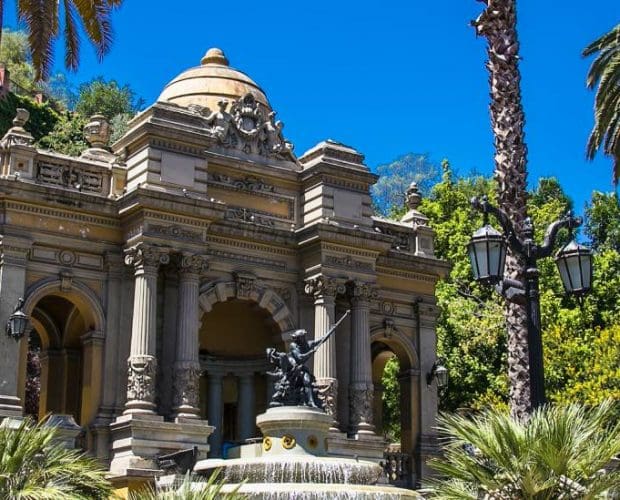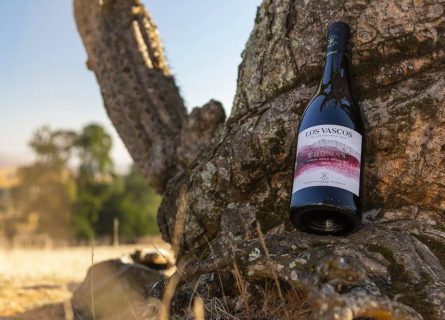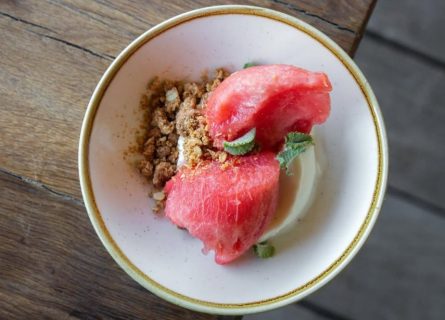Santiago: A dynamic blend of history, culture, and modernity, showcasing resilience and architectural marvels in Chile's cosmopolitan capital.
Read more
Last updated: June 17, 2025
This vast and diverse vineyard includes some of Chile’s most fashionable DOs, encompassing Colchagua, Cachapoal, and the up-and-coming Apalta. Located to the immediate south of Maipo in the Central Valley, Rapel has long been associated with excellent Cabernet Sauvignon, running the whole gamut from Tagua Tagua Family Reserve (over $100) to labels that are sold for less than 15 dollars. This is the enduring secret behind Rapel’s international success: it appeals to both trophy hunters and consumers searching for a relative bargain.
However, velvety Cabernet is not Rapel’s only star turn. This expansive region produces some quite powerful Carmenère, albeit with a fine streak of acidity to balance out such intense fruit. Chardonnay, a grape more readily associated with the cool-climate vineyards of Aconcagua, also thrives in the chillier parts of the valley, as does Sauvignon Blanc. The former can achieve ripeness levels unimaginable in the cold limestone soils of Chablis. If you seek exuberance and vivacity from your wines, read on.
The Rapel Valley has been producing some of Chile’s finest wine since the 19th century, following the introduction of Bordeaux varieties into the exceptional terroirs of the Central Valley. Indeed, despite a burgeoning interest in marketing dry whites, Rapel is still the land of powerful Cabernet and Carmenère; red wine takes up around 80% of production today.
“The Rapel (Rah-PELL) Valley is divided into two regions: Cachapoal to the North and Colchagua to the South. In general, Cachapoal is narrower and a tad cooler than its southern neighbor.”
However, the entire region is noted for its very warm and dry climate, necessitating irrigation to protect vines from hydric stress. The principal source of moisture in the region comes from snowmelt, taken from the Rapel River and dispersed across the valley floor. Without it, viticulture would be hugely difficult here – a single vine needs about 700mm of water a year to survive.
There are many vines in Rapel: approximately 47,00 hectares are cultivated today. The geographical area is very extensive, running from directly south of Maipo to the furthest edge of the Colchagua Valley on the border with Curicó. Named after an eponymous river that bisects the region, Rapel is sandwiched between the Andes and Chile’s Coastal Range. Maritime influences have little impact on day-to-day temperature variations inland. For that reason, both the Colchagua and Cachapoal Valleys are more suited, overall, to the production of red wines.
Yet Chile’s intrepid winemakers have been developing cooler terroirs lately, ascending the foothills and moving closer to the Pacific. In Colchagua, Luis Felipe Edwards has demonstrated that elegance and finesse are entirely possible in this Mediterranean region, expanding his Puquillay Alto Mountain Vineyards in the Colchagua Mountains. Rising to 900 meters above sea level, these low-yielding parcels deliver succulent Carmenère and vibrant sparkling Moscatel, Pinot Gris, Cabernet Sauvignon, and a Bordeaux blend.
A representative from Wines of Chile said.
“Located in the southern half of the Rapel Valley, a two-hour drive from Santiago, the Colchagua Valley has evolved over the past twenty years into one of the country’s largest and most active wine regions.
“The relatively [overall] low elevation of the coastal hills allows the Pacific breezes to interact with the Andean winds, cooling the valley (the heart of which is around 30 miles from the coast) and extending the ripening period.”
They added that some of the region’s leading terroirs include “Marchigüe in Colchagua Costa, where Syrah and Carmenère grow on soil dotted with pebbles and rounded stones left along the path of a melting glacier eons ago.” Meanwhile, investors are flocking to the Pacific-influenced vineyards of Paredones, situated less than 25 kilometers from the ocean. Cooled by maritime breezes, these exceptional climats yield fragrant and super-fresh dry whites that are hard to find in the hotter parts of Rapel. Old vine Semillon is one of its greatest treasures, based on a parcel that dates back to the 1920s. Described as “deliciously fresh with acacia flowers and mandarin zest notes,” the Parellon Semillon deserves a place in Chile’s viticultural hall of fame.
The Cachapoal Valley, meanwhile, benefits from mountain breezes, deep clay soils, more fertile loam (yields have to be controlled on loamy terrain), and volcanic terroirs.
According to Julio Alonso, Executive Director at Wines of Chile (North America):
“The Alto Cachapoal zone occupies a narrow hilly corridor following the banks of the Cachapoal River. In this western Alto region, steep hillsides are home to fruit that eventually makes fresh, tannin-rich reds, as well as serious examples of Chardonnay.
He continues: “The lower reaches of Cachapoal are flatter, warmer, and here are you will find larger producers, who invested heavily here in the 1990s, making fruit-forward, market friendly wines that are enjoyed the world over, from Merlot (a specialty here) to Cabernet Sauvignon.”
Encompassing the subregions of Rancagua, Requinoa, and Rengo, Cachapoal is generally a reliable source of affordable and well-made red wine. However, some very fine dry whites can also be found in the nascent DOs of Los Lingues (north of San Fernando) and Apalta, which Montes and its rival Lapostolle heavily promoted.
This is a country of limitless ambition.

Rapel has traditionally been associated with high-quality Cabernet Sauvignon: full-bodied, blackcurrant-scented delights that offer tremendous value when benchmarked against Napa Valley reds or the more prestigious Maipo labels.
Occasionally blended with Merlot and/or Cabernet Franc, these sumptuous wines have become an export sensation in the US and Western Europe.
Yet, while Rapel Cabernet is often excellent, old vine Carmenère can be truly outstanding—and unique. Although prone to developing an herbaceous quality if underripe, this historic Bordeaux variety is nonetheless one of Chile’s most attractive styles.
The best terroirs yield full-bodied reds of considerable charm, renowned for their red fruit character and aromas of black pepper, nutmeg, chocolate, and capsicum. Rich, refined, and beautifully aromatic, they are a credible alternative to Argentine Malbec.
The management of this complex variety, however, is not always straightforward. Many of the issues that arise in the production of Cabernet Sauvignon are relevant here: Is it preferable to use a cold soak or start the fermentation immediately? How long should the post-fermentation maceration be? And what role should new oak play in shaping the taste of the wine?
Montes Alpha provides a textbook example of how to handle the enigmatic Carmenère. The fruit is sourced from low-yielding parcels in Apalta and Marchigüe, planted on 45° slopes that benefit from cool ocean breezes and diurnal temperature variation. In lesser wineries, grapes are crushed and quickly fermented in tanks, with a relatively brief maceration and little or no time spent in barrel. The result is a drinkable yet utterly nondescript glass of wine.
But this is not the Montes Alpha philosophy. Quality is the only priority at this venerable producer: after manual harvesting, the grapes are treated to a cold soak at 50°F for five days, otherwise known as pre-fermentation maceration. Widely utilized in Bordeaux, this method extracts color and tannin from the pomace, resulting in softer tannins and a more ’rounded’ mouthfeel. Similarly, Montes elects to undertake a precise, computer-monitored control of fermentation temperature, designed to maximize fruit intensity and avoid burned, tarry flavors. After 12 days of vinification in stainless steel, a post-fermentation maceration will take place in tank, imparting structure and color to the wine.
Like Cabernet Sauvignon, Carmenère has a natural affinity with oak, albeit lesser wines can be overwhelmed by the aroma and flavor of new barrique. At Montes, the wine is aged for about 12 months—55% of the final blend is matured in first-, second, and third-use French oak barrels. This produces a supple and harmonious style, with exuberant fruit, elegant tannins, and ripe acidity.
Meanwhile, Rapel’s sizable community of growers continues to make many fine varietals, including Chardonnay, Merlot, Malbec, Syrah, Sauvignon Blanc, and even Viognier. However, while the quality is often impressive, fruit-forward Chilean wines can get a little boring—close facsimiles are available in Argentina and South Africa. For an original and authentic entry into the soils and traditions of this mesmerizing country, drink Carmenère.
Chardonnay is a green-skinned grape varietal native to the Burgundy wine region in France and one of the most popular varieties worldwide.
Find out moreMuscat blanc is a white wine grape varietal popular in the Muscat d'Alsace, Moscato d'Asti and Beaumes-de-Venise regions.
Find out morePinot Gris is a white-wine grape variety originally from Burgundy. It is thought to be a mutant clone of Pinot Noir.
Find out moreThe sauvignon blanc grape varietal, originally from the Bordeaux region of France, is now one of the world's most loved white varieties.
Find out moreSauvignon Gris is a pink-berried mutation of Sauvignon Blanc, originally likely from Bordeaux but now also prominent in Chile. It is a relatively obscure grape, making up only 2% of Bordeaux's white wine grape production. Nearly extinct due to the phylloxera epidemic, its revival is credited to Jacky Preys, a winemaker from the Loire Valley.
Discover Riesling's charm, a white grape from Germany's Rhine region, cherished in Alsace, France. Unveil its secrets and delights
Find out moreDiscover the irresistible allure of Cabernet Sauvignon—a worldwide favorite with robust, dark-bodied flavor. Unleash your wine journey today!
Find out moreCabernet Franc grape is a close relative of Merlot and Cabernet Sauvignon and is the principal blending grape used in Bordeaux.
Find out moreCarménère is a red wine grape from Bordeaux, France, once used for blending but is now mostly grown in Chile. Named for its crimson leaves in autumn, it's part of the Cabernet family and was one of Bordeaux's original six red grapes. Although rare in France today, Chile leads with the largest Carménère vineyards, exploring its blending potential, notably with Cabernet Sauvignon. The grape is also cultivated in Italy, Argentina, and parts of the United States.
Merlot is the most cultivated grape in Bordeaux and closely related to Cabernet Franc
Find out moreDelve into Malbec, a dark, small grape native to France, cherished for its thick skin and exceptional flavors. 🍇🍷
Find out morePinot noir is a light-bodied red wine varietal closely related to the Vitis vinifera grape and produces the most sought-after red wines in the world.
Find out moreSyrah is dark-skinned and perhaps the most underrated of the 'noble' red grape varieties.
Find out more
It’s thirsty work exploring every nook and cranny of Rapel, with vineyards galore and a myriad of different subzones, grape varieties, and terroirs. Fortunately, the vignoble boasts a number of deluxe winery hotels and restaurants, including an outdoor grill, Juegos de Apalta, run by celebrity chef Francis Mallmann. Catering to a diverse and well-heeled clientele, Rapel’s A-list offers sophisticated interpretations of regional classics, invariably based around local meat, seafood, and kitchen garden vegetables. The oysters and langoustines, meanwhile, are sourced directly from the Pacific. Alfresco dining among the vines doesn’t get any better than this.
If you would like us to customize an exclusive luxury tour, contact us and let us know your travel plans. We offer luxury food and wine tours for private groups of a mininium two guests. In addition, all of our private, chauffeured tours are available year-round upon request.

